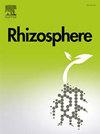细胞外聚合物质和微生物接种剂促进玉米生长和减少灌溉需求
IF 3.5
3区 生物学
Q1 PLANT SCIENCES
引用次数: 0
摘要
土壤改良剂和微生物接种剂可以影响植物生长、保水性和作物抗逆性。本研究研究了细胞外聚合物(EPS)和生物炭两种添加剂在接种和不接种细菌的情况下对玉米生长、灌溉需求和生理反应的影响。玉米在含有2.5%和5% (w/w)湿EPS (Kaumera®)或生物炭的土壤中种植,并接种由烟碱节杆菌EAPPA和红球菌sp. EC35组成的细菌联合体。土壤植物分析发育(SPAD)值表明土壤养分有效性和光合效率显著提高。在未接种的植株中,与未接种的对照植株相比,添加EPS使茎干生物量增加了78%,茎粗增加了9%。这种增强与养分吸收密切相关,特别是在添加5% EPS的植株中。特别是,Mg和Ca浓度分别比未修改的对照组增加了195%和73%。接种进一步放大了这些益处,强调了其在植物发育和恢复力中的关键作用。相比之下,生物炭处理的植物表现出生长减少,表明在测试的添加剂量下存在应激效应。电解质泄漏是植物胁迫的关键指标,经EPS处理的土壤电解质泄漏显著降低,表明EPS对植物具有保护作用。EPS还显示出显著的保水效益,5%的EPS可减少30%的灌溉需求,而生物炭则可减少9%。利用EPS与微生物接种剂相结合,代表了在缺水环境下优化玉米生产的可持续农业战略。本文章由计算机程序翻译,如有差异,请以英文原文为准。
Enhancing maize growth and reducing irrigation needs with extracellular polymeric substances and microbial inoculants
Soil amendments and microbial inoculants can affect plant growth, water retention, and crop resilience. This study investigated the effects of two amendments, extracellular polymeric substances (EPS) and biochar, with and without bacterial inoculation, on maize (Zea mays) growth, irrigation needs, and physiological responses. Maize was cultivated in soil with 2.5 % and 5 % (w/w) of wet EPS (Kaumera®) or biochar and inoculated with a bacterial consortium consisting of Arthrobacter nicotinovorans EAPPA and Rhodococcus sp. EC35.
EPS-treated plants exhibited significantly higher shoot biomass, larger stem thickness, while soil plant analysis development (SPAD) values suggest improved nutrient availability and photosynthetic efficiency. In non-inoculated plants, EPS supplementation increased shoot dry biomass by 78 % and stem thickness by 9 % compared to control plants grown without amendments. This enhancement strongly correlated with nutrient uptake, especially in plants supplemented with 5 % of EPS. Particularly, Mg and Ca concentrations increased by 195 % and 73 %, respectively, compared to non-amended controls. Inoculation further amplified these benefits, underscoring its key role in plant development and resilience. In contrast, biochar-treated plants exhibited reduced growth, suggesting stress effects at the tested addition doses. Electrolyte leakage, a key indicator of plant stress, was significantly lower in soils amended with EPS, suggesting that EPS provides a protective effect to the plants. EPS also demonstrated remarkable water retention benefits, reducing irrigation requirements by 30 % with 5 % of EPS application, compared to 9 % reduction with biochar. The use of EPS, combined with microbial inoculants, represents a sustainable agricultural strategy for optimizing maize production in water-limited environments.
求助全文
通过发布文献求助,成功后即可免费获取论文全文。
去求助
来源期刊

Rhizosphere
Agricultural and Biological Sciences-Agronomy and Crop Science
CiteScore
5.70
自引率
8.10%
发文量
155
审稿时长
29 days
期刊介绍:
Rhizosphere aims to advance the frontier of our understanding of plant-soil interactions. Rhizosphere is a multidisciplinary journal that publishes research on the interactions between plant roots, soil organisms, nutrients, and water. Except carbon fixation by photosynthesis, plants obtain all other elements primarily from soil through roots.
We are beginning to understand how communications at the rhizosphere, with soil organisms and other plant species, affect root exudates and nutrient uptake. This rapidly evolving subject utilizes molecular biology and genomic tools, food web or community structure manipulations, high performance liquid chromatography, isotopic analysis, diverse spectroscopic analytics, tomography and other microscopy, complex statistical and modeling tools.
 求助内容:
求助内容: 应助结果提醒方式:
应助结果提醒方式:


